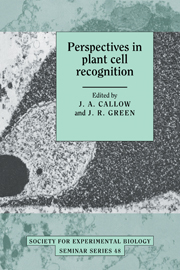Book contents
- Frontmatter
- Contents
- List of contributors
- Preface
- Sexual signalling in Chlamydomonas
- Gamete recognition and fertilisation in the fucoid algae
- The fungal surface and its role in sexual interactions
- Gamete recognition in angiosperms: model and strategy for analysis
- The molecular biology of self-incompatible responses
- Cell surface arabinogalactan proteins, arabinogalactans and plant development
- Local and systemic signalling during a plant defence response
- Contact sensing during infection by fungal pathogens
- The electrophysiology of root–zoospore interactions
- Molecular differentiation and development of the host–parasite interface in powdery mildew of pea
- Recognition signals and initiation of host responses controlling basic incompatibility between fungi and plants
- Cell surface interactions in endomycorrhizal symbiosis
- Host recognition in the Rhizobium leguminosarum–pea symbiosis
- The Rhizobium trap: root hair curling in root–nodule symbiosis
- Structure and function of Rhizobium lipopolysaccharide in relation to legume nodule development
- Index
- Plate section
Sexual signalling in Chlamydomonas
Published online by Cambridge University Press: 07 May 2010
- Frontmatter
- Contents
- List of contributors
- Preface
- Sexual signalling in Chlamydomonas
- Gamete recognition and fertilisation in the fucoid algae
- The fungal surface and its role in sexual interactions
- Gamete recognition in angiosperms: model and strategy for analysis
- The molecular biology of self-incompatible responses
- Cell surface arabinogalactan proteins, arabinogalactans and plant development
- Local and systemic signalling during a plant defence response
- Contact sensing during infection by fungal pathogens
- The electrophysiology of root–zoospore interactions
- Molecular differentiation and development of the host–parasite interface in powdery mildew of pea
- Recognition signals and initiation of host responses controlling basic incompatibility between fungi and plants
- Cell surface interactions in endomycorrhizal symbiosis
- Host recognition in the Rhizobium leguminosarum–pea symbiosis
- The Rhizobium trap: root hair curling in root–nodule symbiosis
- Structure and function of Rhizobium lipopolysaccharide in relation to legume nodule development
- Index
- Plate section
Summary
Introduction
In the unicellular green alga Chlamydomonas the two flagella are used not only for locomotion but also for sexual cell–cell interactions. In a compatible combination of mating-type plus and minus (mt+ and mt−) partners, the cells adhere to each other by their flagella. This results not only in a close proximity of the cell bodies that are going to fuse with each other, but also in the generation of a signal, telling the cells to prepare for fusion. This implies at least the total or partial hydrolysis of the cell wall, and the activation of a specialised zone at the anterior part of the cell surface. Thus, Chlamydomonas is an example in which signalling is generated by physical cell-to-cell contact. This allows us to investigate the nature and behaviour of the surface receptors involved in this process and the mechanism of signal transduction over the surface membrane and inside the cells. Despite the clarity in which these processes in this simple eukaryotic system are exhibited, and the considerable progress that has been made in a number of laboratories, several enigmas remain, which I address in this chapter.
Strategies of gametic approach
Most of the research concerning sexual interactions has been carried out with the heterothallic Chlamydomonas eugametos and Chlamydomonas reinhardtii. In these species, cells within one clone all have the same mating type. So when mt+ and mt− clonal populations are mixed, the cells exhibit sexual conjugation when they are mating-competent.
- Type
- Chapter
- Information
- Perspectives in Plant Cell Recognition , pp. 1 - 18Publisher: Cambridge University PressPrint publication year: 1992
- 2
- Cited by

